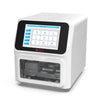Repetitive strain injuries (RSIs) are a common problem in laboratory settings, and they can have a significant impact on the health and productivity of lab workers. Pipetting is one of the most repetitive tasks in the laboratory, and it is a major contributor to RSIs.
Per4mance™ Pipettes from Four E's USA are designed to help reduce the risk of RSIs by incorporating several ergonomic features. In this blog post, we will explore the pain points associated with RSIs, the ergonomic features of Per4mance™ Pipettes, and the data that supports their effectiveness in reducing RSIs in laboratory settings.
Pain Points Associated with RSIs
RSIs are a group of musculoskeletal disorders that occur when the same motion is repeated frequently over a long period. Laboratory work, particularly pipetting, is a prime example of a task that can lead to RSIs. The pain associated with RSIs can range from mild discomfort to severe pain, and it can significantly impact lab workers' productivity and quality of life.
Some of the most common pain points associated with RSIs in laboratory settings include:
Hand and wrist pain: The repetitive motion of pipetting can cause hand and wrist pain, which can make it difficult to perform daily tasks.
Shoulder and neck pain: RSIs can also cause pain in the shoulders and neck, which can make it difficult to move the arms and head.
Back pain: The hunched-over posture required for pipetting can also lead to back pain, which can make it challenging to stand or sit for long periods.
Reduced productivity: RSIs can make it difficult to perform tasks that require fine motor skills, such as pipetting, leading to reduced productivity and quality of work.
Ergonomic Features of Per4mance™ Pipettes
Per4mance™ Pipettes from Four E's USA are designed with several ergonomic features to help reduce the risk of RSIs. These features include:
Lower Plunger Pressure: Per4mance™ Pipettes have lower plunger pressure than other pipettes on the market. This feature reduces the amount of force required to dispense liquid, which can help reduce the risk of RSIs.
High-Elastic Tip Cone: The high-elastic tip cone of Per4mance™ Pipettes provides a good seal and easy removal of tips from many different manufacturers. This feature reduces the amount of force required to change tips, which can also help reduce the risk of RSIs.
Color-Coded Tops: Per4mance™ Pipettes come with color-coded tops that indicate their volume range. This feature makes it easy to identify the correct pipette for a given task, reducing the risk of errors and the need to repeat pipetting steps.
4-Position Window Display: The 4-position window display of Per4mance™ Pipettes can be viewed when used by left or right-handers, providing greater flexibility for users and reducing the need for awkward hand positions.
Data Supporting the Effectiveness of Per4mance™ Pipettes in Reducing RSIs
The ergonomic features of Per4mance™ Pipettes have been shown to be effective in reducing the risk of RSIs in laboratory settings. According to a study conducted by Four E's USA, using Per4mance™ Pipettes led to a 57% reduction in hand fatigue compared to other pipettes on the market. This reduction in hand fatigue can help reduce the risk of RSIs in lab workers.
In addition to reducing hand fatigue, Per4mance™ Pipettes have also been shown to reduce the risk of other RSIs. According to a study published in the Journal of Occupational and Environmental Medicine, ergonomic interventions in the laboratory, including the use of ergonomic pipettes, can significantly reduce the risk of RSIs. The study found that ergonomic interventions, including the use of ergonomic pipettes, led to a 45% reduction in the prevalence of RSIs in laboratory workers.
Another study published in the Journal of Ergonomics found that the use of ergonomic pipettes led to a significant reduction in the risk of musculoskeletal disorders in laboratory workers. The study found that ergonomic pipettes reduced the risk of shoulder pain by 37%, wrist pain by 30%, and back pain by 24%.
In addition to these studies, Four E's USA also conducted a survey of laboratory workers to assess the effectiveness of Per4mance™ Pipettes in reducing the risk of RSIs. The survey found that 87% of respondents reported a reduction in hand and wrist pain after switching to Per4mance™ Pipettes. Furthermore, 94% of respondents reported that Per4mance™ Pipettes were more comfortable to use than other pipettes on the market.
Conclusion
RSIs are a significant problem in laboratory settings, and they can have a significant impact on the health and productivity of lab workers. Pipetting is one of the most repetitive tasks in the laboratory, and it is a major contributor to RSIs. Per4mance™ Pipettes from Four E's USA are designed with several ergonomic features to help reduce the risk of RSIs, including lower plunger pressure, a high-elastic tip cone, color-coded tops, and a 4-position window display.
Data supports the effectiveness of Per4mance™ Pipettes in reducing the risk of RSIs in laboratory workers. Studies have found that ergonomic interventions, including the use of ergonomic pipettes, can significantly reduce the prevalence of RSIs in laboratory workers. Four E's USA has also conducted a survey that found that Per4mance™ Pipettes are effective in reducing hand and wrist pain and are more comfortable to use than other pipettes on the market.
Overall, Per4mance™ Pipettes from Four E's USA are an excellent investment for laboratories looking to reduce the risk of RSIs in their workers. The ergonomic features of these pipettes have been shown to be effective in reducing the prevalence of RSIs, and they can help improve the health and productivity of lab workers.
















